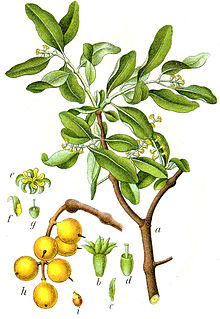Loranthus
| Loranthus | |
|---|---|

| |
| Loranthus europaeus | |
| Scientific classification | |
| Kingdom: | |
| (unranked): | |
| (unranked): | |
| (unranked): | |
| Order: | |
| Family: | |
| Genus: | Loranthus Jacq.
|
Loranthus is a genus of parasitic plants that grow on the branches of woody trees. It belongs to the family Loranthaceae, the showy mistletoe family.[1] In most earlier systematic treatments it contains all mistletoe species with bisexual flowers, though some species have reversed to unisexual flowers, while most modern systematists treat it as a monotypic genus with the only species Loranthus europaeus Jacq. - the summer mistletoe or European yellow mistletoe. In contrast to the well known European or Christmas mistletoe (Viscum album L., Santalaceae or Viscaceae) this species is deciduous. The systematic situation of Loranthus is not entirely clear, and some showy mistletoes in Asia may be true parts of this genus.
Ecology
The showy mistletoes can be found throughout the world. If the genus is treated in a restricted sense, the species L. europaeus is restricted to central-southeastern Europe and Asia Minor, where it often partially parasite species of oak.[citation needed]
Some species of Loranthus, in the broad sense, are troublesome parasites, for example they occur in Kerala India as a menace on mango trees (Mangifera indica), a majority of the Anogeissus latifolia trees in the Biligirirangan Hills of Karnataka are infected by Loranthus sp. and in Africa as pests in cocoa plantations. These plants grows strongly on ageing trees particularly somewhere in the middle of old branches. Once established, it steals minerals and water, as well as block sunlight by covering the encroached place. The flowers of Loranthus europaeus are small, green, usually have four to six parts and may be either unisexual or bisexual. Other species of a broader Loranthus have very large, showy flowers, with blooms in lively colours. The fruits are berries, usually containing a single seed, that are dispersed by birds.[citation needed]

Control
Cutting the branch affected by Loranthus before it spreads to other branches of the tree may be a method of control.[citation needed] For some Asian species using larvae of the Common Jezebel butterfly would be a method of natural control.[citation needed] The leaves of these loranths are food for the larvae. The larvae grow in scores and hence can quickly eat away the leaves of the mistletoe. Moreover, the larvae undergo metamorphosis later into beautiful butterflies called Common Jezebel which are very good pollinators and hence useful for trees.[citation needed]
Traditional medicine
L. ferrugineus is traditionally used for the management of hypertension.[2]
References
- ^ Watson, L., and Dallwitz, M.J. 1992 onwards. The families of flowering plants: descriptions, illustrations, identification, and information retrieval. Loranthus
- ^ Ameer, Omar Z.; Salman, Ibrahim M.; Najim, Hafsa S.; Abdullah, Ghassan Z.; Abdulkarim, Muthanna F.; Yam, Mun Fei; Sadikun, Amirin; Asmawi, Mohamed Z. (2010). "In Vitro Pharmacodynamic Profile of Loranthus ferrugineus: Evidence for Noncompetitive Antagonism of Norepinephrine-induced Vascular Contraction". Journal of Acupuncture and Meridian Studies. 3 (4): 272–82. doi:10.1016/S2005-2901(10)60048-9. PMID 21185543.
Further reading
- Ameer, O.Z.; Salman, I.M.; Yam, M.F.; Allah, H.H. Abd; Abdulla, M.H.; Shah, A.M.; Sadikun, A.; Asmawi, M.Z. (2009). "Vasorelaxant Properties of Loranthus ferrugineus Roxb. Methanolic Extract". International Journal of Pharmacology. 5 (1): 44–50. doi:10.3923/ijp.2009.44.50.
- Ameer, Omar Z.; Salman, Ibrahim M.; Siddiqui, Mohammad Jamshed A.; Yam, Mun F.; Sriramaneni, Raghava N.; Mohamed, Ali J.; Sadikun, Amirin; Ismail, Zhari; Shah, Amin M.; Asmawi, Mohd. Z. (2010). "Pharmacological mechanisms underlying the vascular activities of Loranthus ferrugineus Roxb. In rat thoracic aorta". Journal of Ethnopharmacology. 127 (1): 19–25. doi:10.1016/j.jep.2009.09.057. PMID 19808083.
- Ameer, O.Z.; Salman, I.M.; Siddiqui, M.J.A.; Yam, M.F.; Sriramaneni, R.N.; Sadikun, A.; Ismail, Z.; Shah, A.M.; Asmawi, M.Z. (2010). "Cardiovascular activity of the n-butanol fraction of the methanol extract of Loranthus ferrugineus Roxb". Brazilian Journal of Medical and Biological Research. 43 (2): 186–94. doi:10.1590/S0100-879X2010005000002. PMID 20084331.
- Ameer, Omar Z.; Salman, Ibrahim M.; Siddiqui, Mohammad Jamshed A.; Yam, Mun F.; Sriramaneni, Raghava N.; Sadikun, Amirin; Ismail, Zhari; Shah, Amin M.; Asmawi, Mohamed Z. (2009). "Characterization of the Possible Mechanisms Underlying the Hypotensive and Spasmogenic Effects of Loranthus ferrugineus Methanolic Extract". The American Journal of Chinese Medicine. 37 (5): 991–1008. doi:10.1142/S0192415X09007405. PMID 19885958.
- Ameer, Omar Ziad; Salman, Ibrahim M.; Siddiqui, Mohammad Jamshed Ahmad; Yam, Mun Fei; Sriramaneni, Raghava Naidu; Sadikun, Amirin; Ismail, Zhari; Shah, Amin Malik; Asmawi, Mohd. Zaini (2009). "In Vitro Cholinomimetic Effect of Loranthus Ferrugineus in Isolated Guinea Pig Ileum". Journal of Acupuncture and Meridian Studies. 2 (4): 288–93. doi:10.1016/S2005-2901(09)60070-4. PMID 20633504.
